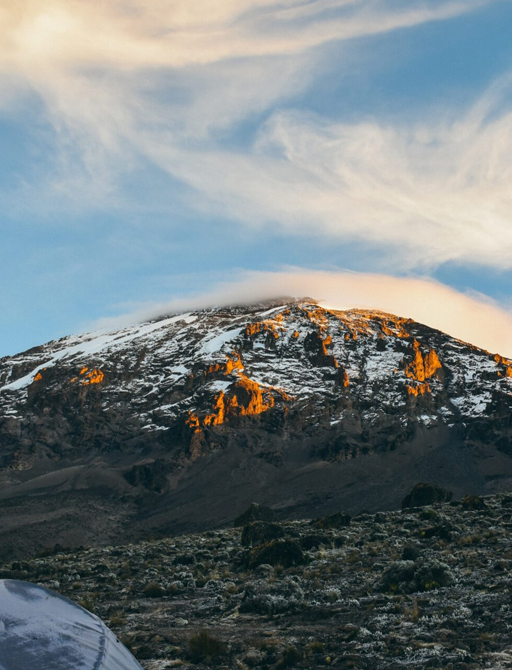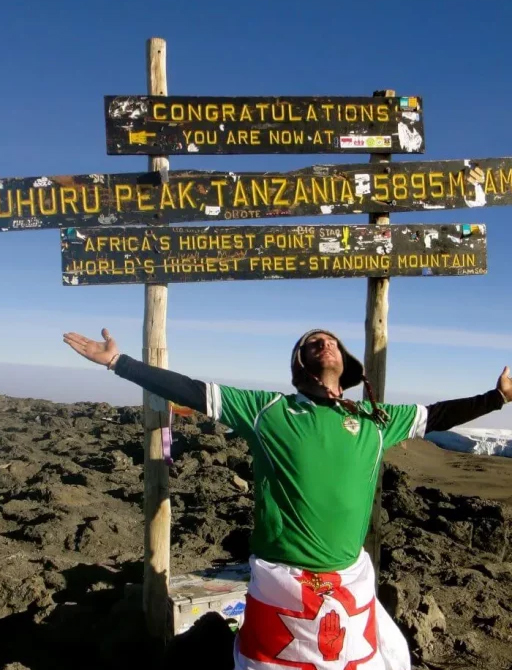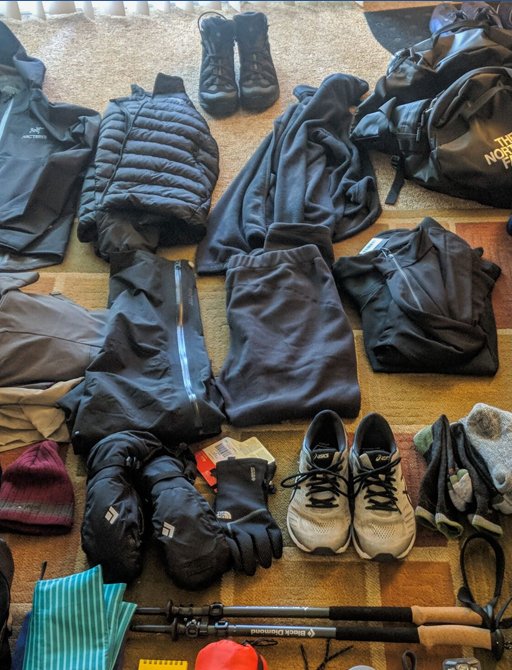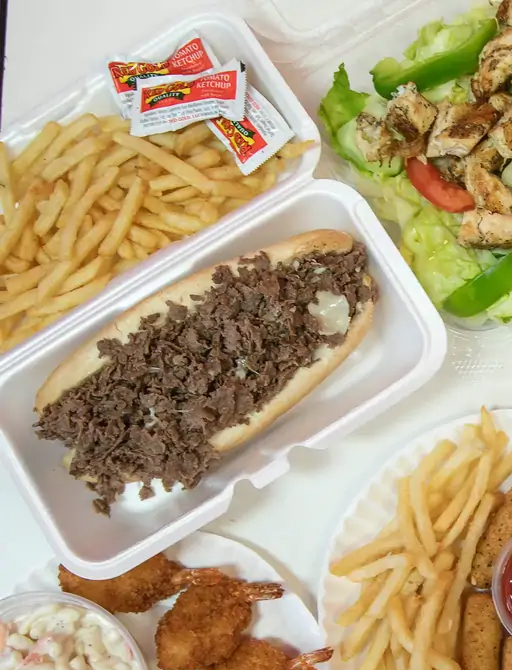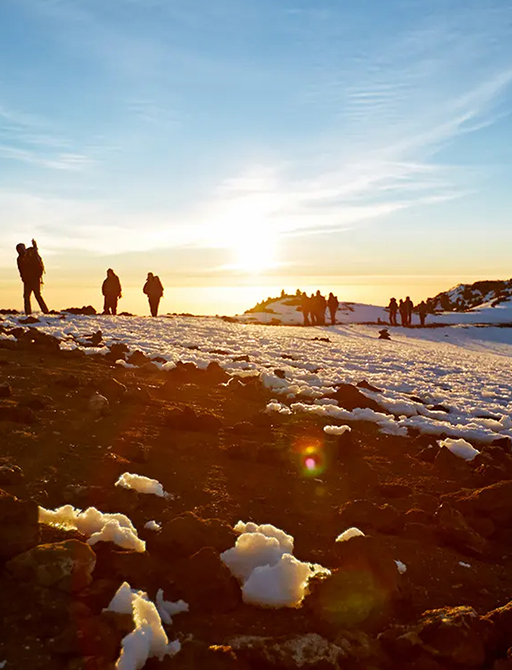Marangu Route
The Marangu Route, one of Kilimanjaro's oldest and most frequented trails, is often referred to as the Coca-Cola route due to the availability of huts and refreshments like Coke along the way. This southeast-facing trail offers a gentler climb, making it a fairly easy choice for trekkers.
However, it's worth noting that the Marangu route doesn't offer optimal acclimatization opportunities, leading to a lower summit success rate compared to other Mount Kilimanjaro Climbing Routes.
A Comprehensive Overview
The Marangu Route covers a distance of around 72 kilometres and is typically completed in 5-6 days. Its relatively shorter duration makes it a challenging yet rewarding journey. Here's a snapshot of what you need to know:
- Distance: Approximately 72 kilometres
- Duration: 5-6 days
- Difficulty: low
- Crowds: As Marangu is perceived as an easier climb because of its gradual slope and direct path, it witnesses larger crowds and is considered a busy route.
- Trail Conditions: As you undertake the hike, you'll traverse through enigmatic cloud-kissed forests, expansive moorlands, and a stark, desert-like alpine zone known as the Saddle.
Scenic Highlights
Marangu is a route of splendid sights and mesmerizing landscapes. From lush rainforests to the awe-inspiring Maundi Crater, there's much to discover: Distinctive Attractions: Rainforests, alpine meadows, Maundi Crater, and the Saddle between Mawenzi and Kibo. Panoramic Views: Spectacular vistas of Mawenzi Peak and the vast plains below
Concise Itinerary
Marangu offers an unforgettable Kilimanjaro Trek, unfolding as follows:
- Start: The trek begins at Marangu Gate, passing through rainforests to Mandara Hut
- Acclimatization: A short acclimatization hike is optional on Day 2 around Horombo Hut
- Summit Push: The final push to the summit is made via Gilman’s Point to Uhuru Peak
- Descent: The descent follows the same route back through Horombo and Mandara Huts
Essential Insights
Despite being a shorter route, Marangu has a success rate of about 65% due to its challenging pace.
Success Rate: Approximately 65%
Best Time to Climb: Dry seasons, namely January-March and June-October
Balancing the Pros and Cons
Marangu has its unique appeal as well as certain challenges:
- Pros: Hut accommodations, less demanding terrain, and fewer starting-day crowds
- Cons: Lower success rate due to rapid altitude gain, less scenic variety due to the same ascent and descent path
Route-Specific Tips
Marangu has some unique aspects that climbers should prepare for:
- Given the route's swift ascent, maintaining a slow pace from day one is crucial
- Nights in the huts can be chilly - pack appropriate thermal layers
The Marangu Route, offering a classic Kilimanjaro Climbing experience with a touch of comfort, is an intriguing choice for those seeking both challenge and convenience. Despite its lower success rate and less scenic variety, the route's historical charm and distinctive hut accommodations make it an enduring favourite among travellers.
Show more...Customize Your Trip
To start planning your tour with us, you can create an itinerary from scratch, or modify one of our suggested itineraries. Want to visit a beautiful destination, or start an adventure to reach the top? We will make it happen.
Tour Guides
Best Time To Climb Kilimanjaro
Technically, you can climb Mount Kilimanjaro at any given time of year. But there are certain months which will make your climbing experience better and worse. This is why it’s important to know What is the Best Time to Climb Kilimanjaro.
High Season
July and August are the peak months in Mountain Kilimanjaro, so if you’re planning to climb Kilimanjaro during this period, book in well-advanced.
Low Season
If rain is not a big concern, you can climb Kilimanjaro in the wet season and shoulder season which receives fewer numbers of crowds.
Kilimanjaro Climbing Cost
Arguably, Mont Kilimanjaro is the perfect spot for adventure lovers, globally. If you planning to scale this mountain, you show how much it cost to climb it. In this guide, we have done a total breakdown of all the factors that are involved in Kilimanjaro Climbing Cost.
Tour Operator
Typically, your biggest expense will be the fee you pay to your chosen tour operator. This cost is inclusive of several key elements
Park Fees
Conservation fee: $70 per day
Camping fee: $50-$60 per night
Rescue fee: $20 per trip
Kilimanjaro Climbing Gear List
Arguably, Mont Kilimanjaro is the perfect spot for adventure lovers, globally. If you planning to scale this mountain, you show how much it cost to climb it. In this guide, we have done a total breakdown of all the factors that are involved in Kilimanjaro Climbing Cost.
The next essentials are camping gear. Your success rate in Kilimanjaro highly depends upon the camping gear you carry with you. So, make sure you are carrying the high-quality and right gear before you climb Kilimanjaro.
Head Gears are also important aspects of the Kilimanjaro Gear List. They protect you from the blistering sun during Kilimanjaro Climbing. Here are some of our recommended head gears to you must need to consider.
Kilimanjaro Foods
During your Mount Kilimanjaro Climbing expedition, you can expect a diverse range of food options that provide a perfect blend of local African cuisine and high-energy mountaineering meals.
High-Energy
During the actual Kilimanjaro Climb, meals are designed to provide the calories and nutrition needed for intense physical effort. Porters and chefs, using portable stoves, cook meals even at the high camps.
Breakfast
Hot drinks like tea, coffee, or hot chocolate
Porridge or cereal for a healthy start
Scrambled eggs, bacon, and sausages for protein
Fresh fruits and toast with butter, jam, or marmalade.
Kilimanjaro Altitude Sickness
Altitude sickness, also known as Acute Mountain Sickness (AMS), is a significant risk when ascending Kilimanjaro due to the rapid elevation gain.
Symptoms
Recognizing the signs of altitude sickness can be vital in ensuring a successful and safe Kilimanjaro Climb.
Preventing
There are several ways to mitigate the risk of AMS during a Mount Kilimanjaro Climbing expedition:
Tipping In Kilimanjaro
Gratuities or Tipping in Kilimanjaro, at the end of a successful climb, carry a deep-seated tradition and noteworthy significance. It's not only a token of gratitude but an essential part of local customs.
Helicopter
With the mission of making Kilimanjaro Africa's safest tourist destination, search, and rescue companies operate high-altitude helicopters crewed by trained medical personnel.
Why Is Tipping
The porters, guides, and cooks are key to your success in summiting Mount Kilimanjaro. They not only ensure you are safe and comfortable during your journey but also provide emotional support when the climb gets tough.
Climbing Kilimanjaro Faq
Climbing Kilimanjaro is a physically demanding, but rewarding adventure.
Mount Kilimanjaro
The nearest airport to Kilimanjaro is Kilimanjaro International Airport (JRO) in Tanzania. Many international flights connect through Dar es Salaam or Nairob
Do I Need A Visa
Yes, a visa is required for most visitors to Tanzania. It can be obtained online, from a Tanzanian embassy, or on arrival.
Electronic Gadgets On Mount Kilimanjaro
Climbing Mount Kilimanjaro, one of the Seven Summits in the world, is a dream come true for many adventure enthusiasts. And to enhance your experience and document this journey, electronic gadgets are invaluable.
Smartphones
In this era of advanced technology, smartphones are a must-have gadget, even on the peaks of Kilimanjaro.
Cameras
Despite smartphones being handy, nothing beats the quality and control offered by a dedicated camera.
kilimanjaro Rescue
Kilimanjaro Rescue represents the crucial emergency procedures designed to swiftly respond and evacuate climbers who face health crises or other emergencies while ascending Mount Kilimanjaro.
Helicopter
With the mission of making Kilimanjaro Africa's safest tourist destination, search, and rescue companies operate high-altitude helicopters crewed by trained medical personnel.
Altitude Sickness
Your safety is our number one priority, and we aim to provide you with all the information needed to prevent and deal with altitude sickness.
Kilimanjaro Porters
Scaling Kilimanjaro is an immense feat, made feasible by the dedication of porters who tirelessly carry heavy loads and prepare camps for climbers.
Kilimanjaro Porters
The Kilimanjaro Porters comprises a team of committed individuals tasked with helping tourists in carrying their gear during the trek.
Key Responsibilities
The main job of a porter is to carry all the luggage belonging to the entire team. The list of items includes gear for each climber, tents, oxygen bottles, stretchers, medical kits, food, sleeping bags, hyperbaric chambers, and toilets.
Kilimanjaro Private Toilet Tents
Discover the ultimate comfort and convenience during your Mount Kilimanjaro expedition with our private toilet tents.
Privacy Amidst
One of the significant advantages of Kilimanjaro Private Toilet Tents is the privacy they provide.
Hygiene
Maintaining proper hygiene and sanitation is essential while Climbing Mount Kilimanjaro.
Kilimanjaro How Long Does It Take
Many travelers planning to climb Mount Kilimanjaro often wonder How Long It Will Take To Climb Kilimanjaro.
How Many Days
The number of days required to Mount Kilimanjaro Climbing can vary significantly based on the route you choose and your climbing experience.
Longer Routes
One major factor to consider when deciding on the duration of your Kilimanjaro climb is the route's length.




